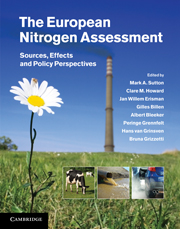Book contents
- Frontmatter
- Contents
- List of contributors
- Foreword
- Summary for policy makers
- Technical summary
- 1 Assessing our nitrogen inheritance
- Part I Nitrogen in Europe: the present position
- Part II Nitrogen processing in the biosphere
- 6 Nitrogen processes in terrestrial ecosystems
- 7 Nitrogen processes in aquatic ecosystems
- 8 Nitrogen processes in coastal and marine ecosystems
- 9 Nitrogen processes in the atmosphere
- Part III Nitrogen flows and fate at multiple spatial scales
- Part IV Managing nitrogen in relation to key societal threats
- Part V European nitrogen policies and future challenges
- Glossary
- Index
- References
8 - Nitrogen processes in coastal and marine ecosystems
from Part II - Nitrogen processing in the biosphere
Published online by Cambridge University Press: 16 May 2011
- Frontmatter
- Contents
- List of contributors
- Foreword
- Summary for policy makers
- Technical summary
- 1 Assessing our nitrogen inheritance
- Part I Nitrogen in Europe: the present position
- Part II Nitrogen processing in the biosphere
- 6 Nitrogen processes in terrestrial ecosystems
- 7 Nitrogen processes in aquatic ecosystems
- 8 Nitrogen processes in coastal and marine ecosystems
- 9 Nitrogen processes in the atmosphere
- Part III Nitrogen flows and fate at multiple spatial scales
- Part IV Managing nitrogen in relation to key societal threats
- Part V European nitrogen policies and future challenges
- Glossary
- Index
- References
Summary
Executive summary
Nature of the problem
Nitrogen (N) inputs from human activities have led to ecological deteriorations in large parts of the coastal oceans along European coastlines, including harmful algae blooms and anoxia.
Riverine N-loads are the most pronounced nitrogen sources to coasts and estuaries. Other significant sources are nitrogen in atmospheric deposition and fixation.
Approaches
This chapter describes all major N-turnover processes which are important for the understanding of the complexity of marine nitrogen cycling, including information on biodiversity.
Linkages to other major elemental cycles like carbon, oxygen, phosphorus and silica are briefly described in this chapter.
A tentative budget of all major sources and sinks of nitrogen integrated for global coasts is presented, indicating uncertainties where present, especially the N-loss capacity of ocean shelf sediments.
Finally, specific nitrogen problems in the European Regional Seas, including the Baltic Sea, Black Sea, North Sea, and Mediterranean Sea are described.
Key findings/state of knowledge
Today, human activity delivers several times more nitrogen to the coasts compared to the natural background of nitrogen delivery. The source of this is the land drained by the rivers. Therefore, the major European estuaries (e.g. Rhine, Scheldt, Danube and the coastlines receiving the outflow), North Sea, Baltic Sea, and Black Sea as well as some parts of the Mediterranean coastlines are affected by excess nutrient inputs.
Biodiversity is reduced under high nutrient loadings and oxygen deficiency. This process has led to changes in the nutrient recycling in sediments, because mature communities of benthic animals are lacking in disturbed coastal sediments. The recovery of communities may not be possible if high productivity and anoxia persist for longer time periods.
- Type
- Chapter
- Information
- The European Nitrogen AssessmentSources, Effects and Policy Perspectives, pp. 147 - 176Publisher: Cambridge University PressPrint publication year: 2011
References
- 20
- Cited by



